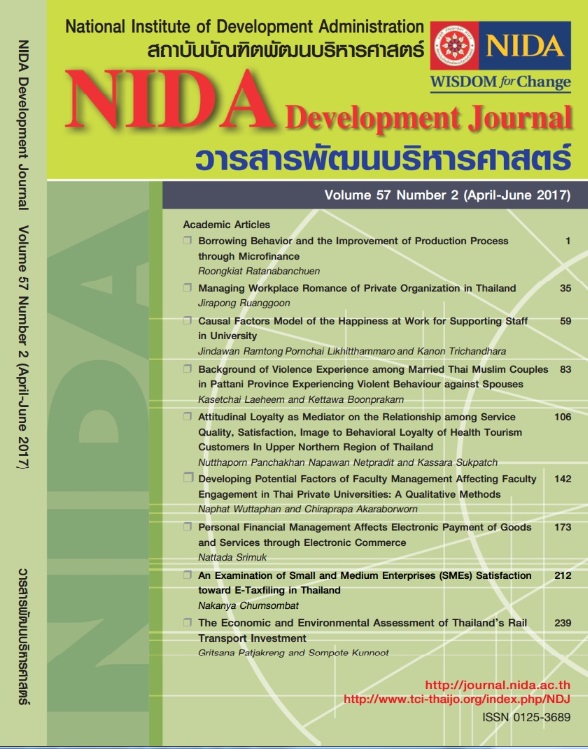โมเดลปัจจัยเชิงสาเหตุความสุขในการทำงานของบุคลากรสายสนับสนุนในมหาวิทยาลัย (Causal Factors Model of the Happiness at Work for Supporting Staff in University)
Keywords:
โมเดลปัจจัยเชิงสาเหตุ, ความสุขในการทำงาน, บุคลากรสายสนับสนุน, Causal Factors Model, Happiness at Work, Supporting StaffAbstract
การวิจัยความสัมพันธ์เชิงสาเหตุมีวัตถุประสงค์เพื่อวิเคราะห์ปัจจัยเชิงสาเหตุความสุขในการทำงานของบุคลากรสายสนับสนุนในมหาวิทยาลัย กลุ่มตัวอย่าง คือ บุคลากรสายสนับสนุน มหาวิทยาลัยสงขลานครินทร์ วิทยาเขตหาดใหญ่ 313 คน สุ่มกลุ่มตัวอย่างแบบแบ่งชั้น เครื่องมือวิจัยเป็นแบบสอบถามออนไลน์ที่ผ่านการตรวจสอบความตรงของเนื้อหาจากผู้เชี่ยวชาญ 3 ท่าน ปรากฏค่าดัชนีระหว่าง 0.66-1.00 ทุกข้อ วิเคราะห์ข้อมูลโดยหาค่าร้อยละ ค่าเฉลี่ย ค่าเบี่ยงเบนมาตรฐาน ค่าความเบ้ ค่าความโด่ง ค่าต่ำสุด ค่าสูงสุด ค่าสัมประสิทธิ์สหสัมพันธ์แบบเพียร์สัน ค่า EFA และโมเดลสมการโครงสร้าง
ผลการศึกษา พบว่า โมเดลปัจจัยเชิงสาเหตุความสุขในการทำงานมีความสอดคล้องกลมกลืนกับข้อมูลเชิงประจักษ์ โดยตรวจสอบจาก c2=2.65, P-Value=.62, GFI=1.00, AGFI=.99, RMR=.015 และ RMSEA=.00 ทั้งนี้ความสุขในการทำงานแยกเป็นสองตัวแปร คือ ตัวแปรสุขภาพจิตและสังคม และตัวแปรครอบครัวและสุขภาพ ตัวแปรสุขภาพจิตและสังคมได้รับอิทธิพลทางตรงจากตัวแปรลักษณะงาน ตัวแปรครอบครัวและสุขภาพ ตัวแปรสภาพแวดล้อมในการทำงาน ตัวแปรสัมพันธภาพกับผู้บังคับบัญชา และตัวแปรสัมพันธภาพกับเพื่อนร่วมงาน และได้รับอิทธิพลทางอ้อมจากตัวแปรสภาพแวดล้อมในการทำงาน และตัวแปรลักษณะงาน ส่วนตัวแปรครอบครัวและสุขภาพได้รับอิทธิพลทางตรงจากตัวแปรสภาพแวดล้อมในการทำงาน และตัวแปรลักษณะงาน ตัวแปรเชิงสาเหตุในโมเดลสามารถร่วมกันอธิบายความแปรปรวนของตัวแปรสุขภาพจิตและสังคม ได้ร้อยละ 59 และตัวแปรครอบครัวและสุขภาพ ได้ร้อยละ 69 ดังนั้น ผู้บริหารและผู้ที่เกี่ยวข้องจึงควรให้ความสำคัญกับการบริหารงานบุคคล ควรมีแนวทางในการส่งเสริมและสนับสนุนให้บุคลากรมีความสุขในการทำงานมากยิ่งขึ้น
Abstract
The objective of this causal relationships research was to analysis causal factors of happiness at work among supporting staff in university. The subjects of the study were 313 supporting staff of Prince of Songkla University, Hat Yai Campus selected using stratified sampling. The online questionnaire, which used for data collection, be validated by 3 experts and the index values between 0.66-1.00 for all items. The data analyzed by the percentage, mean, standard deviation, skewness, kurtosis, minimum, maximum, EFA and structural equation modelling.
The study result found that the causal factors model of the happiness at work was consistent with empirical data: c2=2.65, P-Value=.62, GFI=1.00, AGFI=.99, RMR=.015 and RMSEA=.00. The happiness at work could be specified in two variables. First variables mental health and social variables. Second was family and health variables. It was found that the variables that directly effected to mental health and social variables were job characteristics, family and health, work environment, relationships with supervisors and relationships with colleagues. And the variables that indirectly effected to mental health and social variables were work environment and job characteristics. The variables that directly effected to mental family and health variables were work environment and job characteristics. Causal variables in the model explain the variance of mental health and social variables at 59% and family and health variables at 69%. So executives management and those involved should take attention to personnel management. It should provide guidelines to promote and encourage staff to be happiness at work even more.





